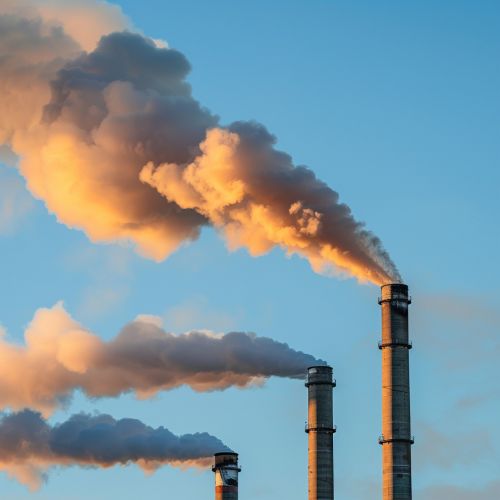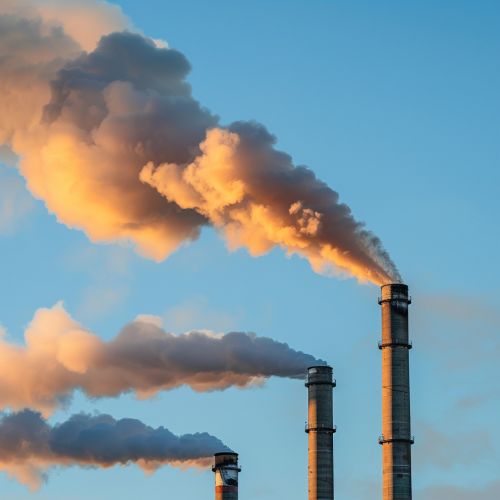Nitrogen Oxides: Difference between revisions
(Created page with "== Introduction == Nitrogen oxides (NOx) are a group of highly reactive gases that contain nitrogen and oxygen in varying amounts. These compounds play a significant role in atmospheric chemistry, environmental science, and industrial processes. The most common nitrogen oxides are nitric oxide (NO) and nitrogen dioxide (NO2), but the group also includes nitrous oxide (N2O), dinitrogen trioxide (N2O3), dinitrogen tetroxide (N2O4), and dinitrogen pentoxide (N2O5). == Chem...") |
No edit summary |
||
| Line 23: | Line 23: | ||
Ongoing research aims to develop more efficient and cost-effective methods for reducing NOx emissions. Advances in [[catalysis]], materials science, and environmental engineering are expected to contribute to better mitigation strategies. Additionally, understanding the complex interactions between NOx and other atmospheric constituents remains a key area of study in atmospheric chemistry. | Ongoing research aims to develop more efficient and cost-effective methods for reducing NOx emissions. Advances in [[catalysis]], materials science, and environmental engineering are expected to contribute to better mitigation strategies. Additionally, understanding the complex interactions between NOx and other atmospheric constituents remains a key area of study in atmospheric chemistry. | ||
[[Image:Detail-97331.jpg|thumb|center|Industrial smokestacks emitting gases against a blue sky.|class=only_on_mobile]] | |||
[[Image:Detail-97332.jpg|thumb|center|Industrial smokestacks emitting gases against a blue sky.|class=only_on_desktop]] | |||
== See Also == | == See Also == | ||
Latest revision as of 14:16, 27 July 2024
Introduction
Nitrogen oxides (NOx) are a group of highly reactive gases that contain nitrogen and oxygen in varying amounts. These compounds play a significant role in atmospheric chemistry, environmental science, and industrial processes. The most common nitrogen oxides are nitric oxide (NO) and nitrogen dioxide (NO2), but the group also includes nitrous oxide (N2O), dinitrogen trioxide (N2O3), dinitrogen tetroxide (N2O4), and dinitrogen pentoxide (N2O5).
Chemical Properties
Nitrogen oxides exhibit a range of chemical properties due to the different oxidation states of nitrogen. NO is a colorless gas that reacts readily with oxygen to form NO2, a reddish-brown gas with a characteristic sharp, biting odor. N2O is a colorless, non-flammable gas with a slightly sweet odor, commonly known as laughing gas. N2O3 and N2O4 are less stable and exist primarily in equilibrium with NO and NO2 under certain conditions. N2O5 is a white solid that decomposes into NO2 and O2 at room temperature.
Formation and Sources
Nitrogen oxides are produced through both natural and anthropogenic processes. Natural sources include lightning, wildfires, and microbial activity in soils. Anthropogenic sources primarily involve combustion processes, such as those occurring in internal combustion engines, power plants, and industrial facilities. The high temperatures in these processes facilitate the reaction between nitrogen and oxygen in the air, forming NOx.
Environmental Impact
NOx compounds are significant contributors to air pollution and have various environmental impacts. They play a crucial role in the formation of tropospheric ozone, a major component of smog. NOx also contributes to the formation of acid rain by reacting with water vapor to form nitric acid (HNO3). Additionally, NOx can lead to the formation of particulate matter (PM), which has adverse health effects.
Health Effects
Exposure to nitrogen oxides can have serious health implications. Short-term exposure to high levels of NO2 can cause respiratory problems, including inflammation of the airways, reduced lung function, and increased susceptibility to respiratory infections. Long-term exposure can lead to the development of chronic respiratory diseases, such as asthma and chronic obstructive pulmonary disease (COPD).
Industrial Applications
Nitrogen oxides have several industrial applications. N2O is used as an anesthetic in medical settings and as a propellant in the food industry. NO and NO2 are used in the production of nitric acid, which is a key component in fertilizers, explosives, and other chemicals. NOx gases are also involved in various catalytic processes, including the selective catalytic reduction (SCR) of NOx emissions from industrial sources.
Mitigation Strategies
Various strategies are employed to mitigate NOx emissions. These include technological solutions such as catalytic converters in vehicles, which reduce NOx to nitrogen and oxygen. Industrial facilities use SCR and selective non-catalytic reduction (SNCR) technologies to lower NOx emissions. Regulatory measures, such as emission standards and air quality regulations, also play a crucial role in controlling NOx levels.
Research and Future Directions
Ongoing research aims to develop more efficient and cost-effective methods for reducing NOx emissions. Advances in catalysis, materials science, and environmental engineering are expected to contribute to better mitigation strategies. Additionally, understanding the complex interactions between NOx and other atmospheric constituents remains a key area of study in atmospheric chemistry.


See Also
References
- [1] Seinfeld, J. H., & Pandis, S. N. (2016). Atmospheric Chemistry and Physics: From Air Pollution to Climate Change. John Wiley & Sons.
- [2] Finlayson-Pitts, B. J., & Pitts Jr, J. N. (2000). Chemistry of the Upper and Lower Atmosphere: Theory, Experiments, and Applications. Academic Press.
- [3] U.S. Environmental Protection Agency. (2021). Nitrogen Oxides (NOx) Control Regulations. Retrieved from https://www.epa.gov/no2-pollution
